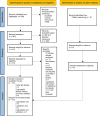The search for gastrointestinal inflammation in autism: a systematic review and meta-analysis of non-invasive gastrointestinal markers
- PMID: 38233886
- PMCID: PMC10795298
- DOI: 10.1186/s13229-023-00575-0
The search for gastrointestinal inflammation in autism: a systematic review and meta-analysis of non-invasive gastrointestinal markers
Abstract
Background: Gastrointestinal symptoms and inflammatory gastrointestinal diseases exist at higher rates in the autistic population. It is not clear however whether autism is associated with elevated gastrointestinal inflammation as studies examining non-invasive faecal biomarkers report conflicting findings. To understand the research landscape and identify gaps, we performed a systematic review and meta-analysis of studies measuring non-invasive markers of gastrointestinal inflammation in autistic and non-autistic samples. Our examination focused on faecal biomarkers as sampling is non-invasive and these markers are a direct reflection of inflammatory processes in the gastrointestinal tract.
Methods: We extracted data from case-control studies examining faecal markers of gastrointestinal inflammation. We searched PubMed, Embase, Cochrane CENTRAL, CINAHL, PsycINFO, Web of Science Core Collection and Epistemonikos and forward and backwards citations of included studies published up to April 14, 2023 (PROSPERO CRD42022369279).
Results: There were few studies examining faecal markers of gastrointestinal inflammation in the autistic population, and many established markers have not been studied. Meta-analyses of studies examining calprotectin (n = 9) and lactoferrin (n = 3) were carried out. A total of 508 autistic children and adolescents and 397 non-autistic children and adolescents were included in the meta-analysis of calprotectin studies which found no significant group differences (ROM: 1.30 [0.91, 1.86]). Estimated differences in calprotectin were lower in studies with siblings and studies which did not exclude non-autistic controls with gastrointestinal symptoms. A total of 139 autistic participants and 75 non-autistic controls were included in the meta-analysis of lactoferrin studies which found no significant group differences (ROM: 1.27 [0.79, 2.04]).
Limitations: All studies included in this systematic review and meta-analysis examined children and adolescents. Many studies included non-autistic controls with gastrointestinal symptoms which limit the validity of their findings. The majority of studies of gastrointestinal inflammation focused on children under 12 with few studies including adolescent participants. Most studies that included participants aged four or under did not account for the impact of age on calprotectin levels. Future studies should screen for relevant confounders, include larger samples and explore gastrointestinal inflammation in autistic adolescents and adults.
Conclusions: There is no evidence to suggest higher levels of gastrointestinal inflammation as measured by calprotectin and lactoferrin are present in autistic children and adolescents at the population level. Preliminary evidence suggests however that higher calprotectin levels may be present in a subset of autistic participants, who may be clinically characterised by more severe gastrointestinal symptoms and higher levels of autistic traits.
Keywords: Autism; Biomarkers; Calprotectin; Gastrointestinal; Inflammation; Lactoferrin.
© 2024. Crown.
Conflict of interest statement
The authors declare no competing interests.
Figures



References
Publication types
MeSH terms
Substances
Grants and funding
- Research Training Program/Australian Government Department of Education, Skills and Employment
- Research Training Program/Australian Government Department of Education, Skills and Employment
- Top up scholarship/Neuroscience Research Australia
- PhD Pearls Program/Neuroscience Research Australia
- GXX0049/Neuroscience Research Australia
LinkOut - more resources
Full Text Sources
Miscellaneous

